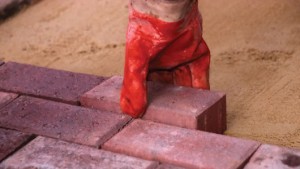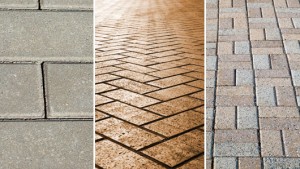
How to lay a brick patio
Lavish outdoor living spaces are very popular with homeowners, and many of them begin with a brick patio, often large and multi-leveled. To ensure these outdoor additions deliver the luxury and quality homeowners want, many are having the work done by professionals. Here’s how to lay a brick patio and provide your customers with a perfect job.
Prepare the ground
Mark the patio area using stakes. Before you dig, verify that there are no utilities or sprinkler systems near the surface. Dig the area to a depth of 8 inches with a gentle slope away from structures (¼ inch for every running foot). Check the area with a level.
Tamp the soil with a hand tamper. You can make one by nailing a 12-inch length of 2-by-6 to a 4-foot length of 6-by-6. Cover the area with a sheet of landscaping material as a barrier against moisture and weeds. Bring in gravel to cover the area to a depth of 2 inches and tamp it. Again, check that the area is level. If you are using 6-by-6 as edging, put it in place now.
Add or remove gravel to keep the edge level with the final patio height.
Add gravel to fill the area to 4 inches from the height of the finished patio and tamp it. Continue adding gravel and tamping until the compacted area is 4 inches from the final patio height.
Add sand and screed it with a length of 2-by-4 to a level surface 2 inches below the final patio height.
Edge it
Use edging to keep patio material in place and maintain a finished edge. To install a brick edge, stand the brick on end on the tamped ground before adding gravel. If you are using 6-by-6 to edge the patio, install it on the first layer of gravel, after tamping. The lumber should be even with the final patio height.
If you are edging with preformed metal, install it on the tamped sand before laying brick.

Tap the brick you are laying against the brick in the previous row and then against the brick beside it before laying it in place.
How to lay a brick patio
After the sand is tamped, avoid kneeling or standing on it or the bricks. Instead, stand or kneel on plywood set on the sand or bricks.
Start in one corner and run a mason’s line across the patio to keep the rows of bricks straight. The mason’s line will serve as a guide to keep the rows straight.
Lay the bricks in the desired pattern and use the double-click method: Tap the brick you are laying against the brick in the previous row and then against the brick beside it before laying it in place. This keeps the sand from pushing up between the bricks. Tap the brick into the sand with a rubber mallet to settle it.
Depending on the pattern the homeowner selected, you will probably have to cut bricks. Lay all full brick sections first, saving the cuts until last. Cut the bricks with a wet tile saw.
Finish work
When all bricks are in place, throw sand across the surface and sweep it into the cracks between the bricks. Gently hose or mist the patio to settle the sand. Add more sand until all the gaps are filled. (Using a polymer sand that sets up when wet will add stability and help prevent weeds.)
Finally, use a paint roller or garden sprayer to apply clear masonry sealer to the pavers. This makes them less porous, less likely to stain, and more resistant to weather.
Estimating materials
To estimate the materials you will need, first calculate the area of the patio. If the patio design is square or rectangle, multiply the width times the length. If there are curves and other shapes, you’ll have to estimate the amount of material those areas will need.
A standard brick paver is 4 inches x 8 inches and 45 pavers cover 10 square feet. A 10 foot X 12 foot patio equals 120 square feet. Divide 120 by 10 (the area covered by 45 pavers) which equals 12. Multiple 12 by 45 pavers and you need 540 pavers to build the patio. Add another 10 percent for cuts, damage and discoloration, to bring the total to 594.
To calculate how much gravel (ground limestone or granite) you’ll need for the 4-inch base, multiply the area of the patio by .333. For our example, that’s 40 cubic feet or 1.5 cubic yards. You will need 1/3 that amount for the sand base. That’s 40 times .333, or approximately 13 cubic feet.
—By Steve Sturgess



